Spray painting fabric at home can be an affordable and fun way to update old furniture and give it a fresh look. The good news is that with some preparation and suitable materials.
Anyone can learn how to spray paint fabric at home. Whether you’re looking to update any home decorations. spray painting fabric is a great DIY project that anyone can do. So, grab some paint, and let’s begin
We’ll take you through the step-by-step process of spray painting fabric, from choosing the right paint and fabric to preparing your workspace and applying the paint. We’ll also share some tips and tricks for achieving the best results so that you can transform your old furniture into something new and stylish.
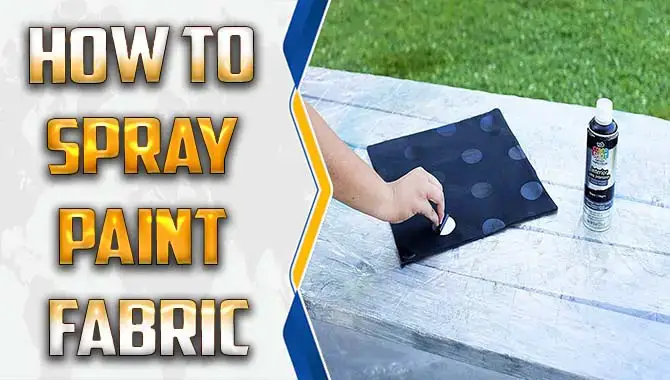
Exploring How To Spray Paint Fabric At Home Easily
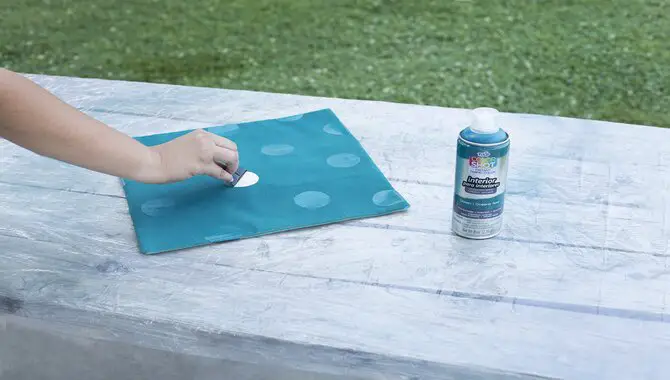
Spray painting fabric at home can be an affordable and fun way to update old furniture and give it a fresh look. The good news is that with some preparation and suitable materials. Anyone can learn how to spray paint fabric at home.
Spray painting fabric is a great way to transform your old clothes or home décor items into something new and exciting. However, many people shy away from this DIY project, assuming it’s too difficult or messy. In reality, it’s a lot easier but you can easily learn to do this at home with a few basic materials and some simple techniques. Whether you’re looking to update an old couch, revamp some throw pillows, or add some color to your curtains, spray painting fabric is a great DIY project that anyone can do.
Materials Needed For Spray Painting Fabric
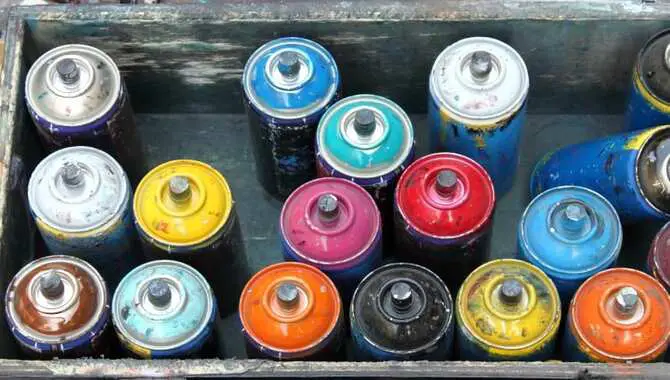
If you’re looking to spray paint fabric, there are a few materials you will need to gather before getting started. First and foremost, you will need fabric spray paint. This type of paint is specifically designed to adhere to fabrics and withstand wear and tear.
Next, you must choose the right fabric type for your project. Cotton and polyester work well with fabric spray paint, while silk and wool may not produce the desired results. It’s also important to have a clean and dry surface to work with, so make sure to wash and dry your fabric before beginning the painting process.
It’s also important to use the right tools, such as brushes, rollers, or spray guns, and to apply the paint or coating in thin, even layers. This helps to cover all surface areas evenly, and minimizing any brush or roller marks.
Preparing The Fabric For Spray Painting
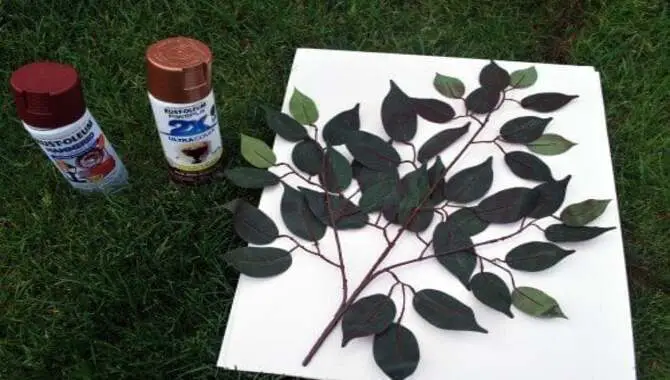
To achieve an even better result when preparing the fabric for spray painting, you can take some additional steps. After washing and drying the fabric, try soaking it in hot water with a small amount of fabric softener.
This will help relax any creases or stubborn wrinkles. Next, use an iron on a low heat setting to create a smoother surface. To ensure better coverage, apply a base coat of white paint before adding your desired color. The vibrancy of your painted fabric will amaze you.
Choosing The Best Fabric Spray Paint
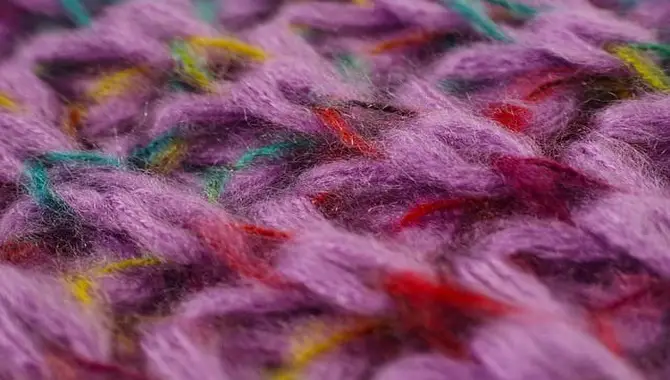
When choosing the best fabric spray paint for your DIY projects, selecting one explicitly designed for fabrics is crucial. Along with considering color options, coverage, and durability, you can experiment with techniques like stenciling or misting to achieve unique effects.
Don’t forget to protect your workspace with cardboard or drop cloths and test the spray paint on a small area first. Check out Walmart or Amazon affiliate links for affordable options. For brands like upholstery fabric by Tulip or vinyl dye by Rust-Oleum check reputable stores.
Blending And Shading Colors
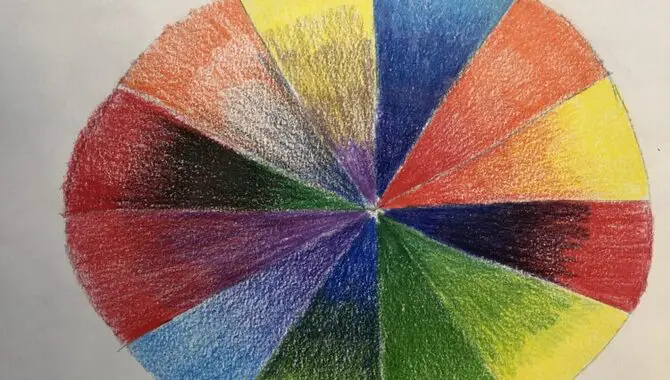
Blending and shading colors are essential for anyone interested in art or design. Creating smooth transitions between different hues is critical in painting, drawing, and digital art. Blending colors requires understanding color theory and technique, patience, and practice. One way to blend colors is using a blending tool or brush, which helps create a gradient effect.
Another technique is to layer different colors over each other, gradually building up the intensity and depth of the colors. Shading colors is another important skill that involves creating the illusion of depth and dimensionality in a two-dimensional image. Shading involves understanding how light and shadow interact with different surfaces and using cross-hatching, stippling, and smudging techniques to create the desired effect.
Achieving Even Coverage

Achieving even coverage is an essential aspect of many processes, especially when it comes to painting or coating surfaces. Whether it’s a wall, a car, or a piece of furniture, the goal is always to apply an even layer of paint or coating with no patchy areas or uneven spots.
Achieving this requires careful preparation, including proper cleaning and sanding of the surface, as well as selecting the right type of paint or coating for the job.
Techniques For Spray Painting Fabric
For successful spray painting fabric projects, opting for the appropriate type of paint is necessary. You should also conduct a patch test to verify if the spray paint adheres well and does not bleed on your textile surface. During spraying, maintain a nozzle distance of 6-8 inches and apply thin mist-like coats with even pressure. Lastly, ensure enough drying time before using or laundering your painted fabrics.
Using stencils For Designs
To achieve beautiful designs when using stencils in fabric spray painting projects, there are some essential guidelines to remember. Select the appropriate stencil based on your project’s size and shape. Secondly, make sure you securely attach it to your fabric before beginning to avoid smudging or bleeding.
Lastly, utilize a light touch when spraying several coats of paint not to oversaturate or ruin your work. These simple steps can help you produce stunning results perfect for anything from upholstery fabric to t-shirts.
Using Cardboard As A Protector
Protecting the surrounding area is crucial to achieving a clean finish while spraying painting fabrics. You can use cardboard as a protector to prevent overspray or any form of stain on the surface beneath your fabric. Ensure that you cut out the cardboard in the shape of what you intend to spray paint and place it underneath your fabric.
This method works well with fabrics like upholstery, textiles, nylon, denim, and polyester. Use high-quality fabric spray paint like acrylic or latex-based paint for better results. You can purchase it from retailers like Walmart or Amazon.
Using The Right Nozzle
Selecting the appropriate nozzle for your specific project is crucial to achieving optimal results. When spraying painting fabrics like upholstery or cushion covers. At the same time, a broader nozzle can cover more surface area at once and speed up the process of spraying paint on items such as denim or polyester garments or outdoor upholstery fabrics on patio furniture or living room decor pieces without having unwanted wrinkles or stains.
A narrower nozzle provides greater accuracy and detail but takes more time for large-scale projects like seasonal decorations. Consider experimenting with different types of paint, like acrylic or aerosol sprays combined with textile medium and primer, to get an optimal color blend before applying multiple coats of paint while ensuring humidity levels are moderate.
Maintain Opacity And Continuity
To get the best results when spraying paint fabric, you must consider opacity and continuity. Opacity refers to how visible the color is after spraying. At the same time, continuity is about how smooth and even the color appears. You must use spray paint for fabrics and prepare your material before achieving these goals.
You’ll want to avoid over-saturating your fabric by spraying from a distance in light coats. Following these steps will help you achieve professional-looking results that make your upholstered furniture or DIY projects look new again.
Drying And Curing The Fabric
Drying and curing the fabric is a critical process in textile manufacturing. This process involves removing moisture from the fabric and stabilizing its fibers to ensure its durability and quality. The first step in this process is drying the fabric. You can do this using various methods such as air-drying, tumble drying, or heat drying. The choice of method depends on the fabric type and its intended use. Once the fabric is dry, it is ready for the curing process.
Curing involves subjecting the fabric to high temperatures to stabilize its fibers. This process is essential to ensure the fabric’s strength and prevent shrinkage during washing. The curing process can be done using various methods, including heat, chemical, and infrared. Each method has its advantages and disadvantages, and the choice of method depends on the type of fabric, the desired end product, and the manufacturer’s preferences.
Heat Set The Fabric
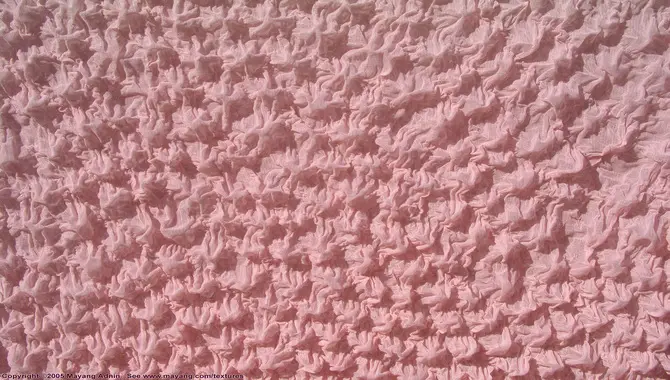
Heat setting the fabric is a crucial step in the textile industry. It involves the application of heat to the fabric to improve its strength, durability, and shape retention. This process is typically done after the fabric is woven or knitted, and it helps to ensure that the fabric maintains its shape and size during subsequent handling and washing. Heat setting is achieved through either a dry or wet method, depending on the type of fabric and its intended use
The dry method involves passing the fabric through a series of heated rollers, which apply pressure and heat to the material. This process helps to set the fabric’s fibers in place and improve its dimensional stability. On the other hand, the wet method involves steaming the fabric under pressure to achieve the same results. Heat setting also helps to prevent the fabric from shrinking or stretching during washing or handling.
Care For Spray-Painted Fabric
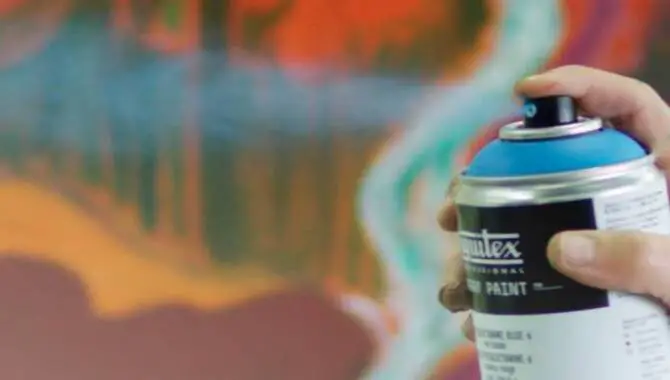
To ensure your spray-painted fabric maintains its appearance for more extended periods, it is crucial to follow proper care instructions. Once you have completed your project and applied the final coat of paint, allow it to dry for at least 72 hours before washing it for the first time.
Be sure to wash your item using only a mild detergent with cold water. Avoid using fabric softeners or bleach, as they can cause damage to the paint and overall quality of your piece. After washing your item, allow it to air dry instead of putting it in the dryer, as high heat can cause wrinkles or stains on the painted area. It’s also essential to avoid ironing directly on the painted area as this could cause damage or even remove some paint.
Types Of Fabric Spray Paint
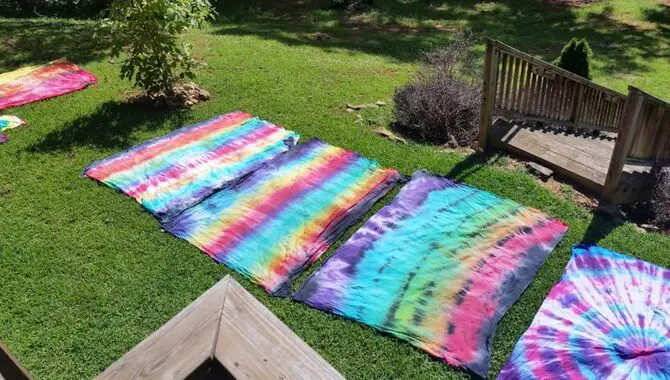
When it comes to fabric painting, one should know that there are two primary types available in the market: acrylic-based and dye-based. Acrylic-based spray paints are known for their durability and come in various shades for upholstery fabrics or DIY projects. People prefer dye-based sprays to give T-shirts or garments a soft yet vibrant look. Testing the paint on some scrap cloth before applying it to any garment is always recommended.
Dye-Based Fabric Spray Paint
When looking to add color to fabrics, dye-based fabric spray paint is ideal as it dries quickly without requiring any heat setting. People use this spray paint on various fabrics because of its ability to be used on them, including polyester, cotton, and blends.
Selecting the suitable dye for your textile material is crucial to get the best results possible and ensure that your newly painted fabric lasts long. Remember always to follow the manufacturer’s instructions strictly. This convenient option will give your t-shirts or upholstery fabric a new life!
Latex-Based Fabric Spray Paint
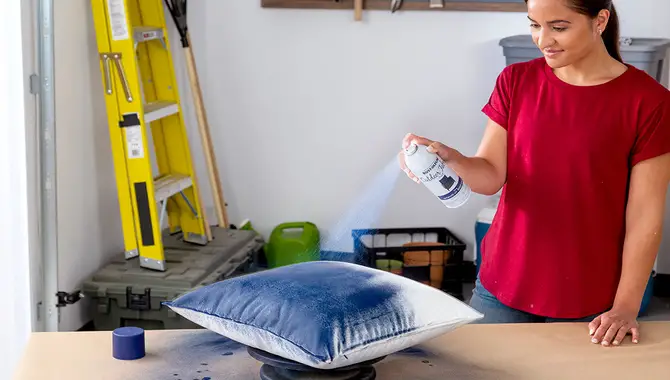
Suppose you’re new to spraying fabric with color or are looking for an affordable option for your DIY projects like cushions or textiles. Such as t-shirts and upholstery fabrics, then Latex-based fabric spray paint should be your go-to choice.
Ensure that your fabric is clean and dry before beginning; you can add a base coat of white paint to get better coverage. Apply thin coats of latex spray paint evenly and wait for each coat to dry completely before adding another one. Be patient when drying the painted surface completely, don’t rush by using a dryer; instead, choose a warm moisture-free environment.
Conclusion
Spray painting fabric is an affordable and accessible DIY project that can give your old furniture, curtains, or clothes a new lease of life. The process involves choosing the right fabric spray paint, preparing the fabric, and using the proper techniques to achieve the desired result. Whether you’re using dye-based or latex-based fabric spray paint, it’s essential to ensure opacity and continuity for even coverage.
You can use stencils to create unique designs and protect surfaces with cardboard. Once you’re done, take care of your newly spray-painted fabric by following the care instructions provided with the product. So why wait? Get creative and transform your home decor with our easy guide on how to spray paint fabric at home today.
Frequently Asked Questions
Can I Use Spray Paint On Fabric?
Spray paint can use on fabric with the right type of spray paint. Look for a product specifically designed for the fabric to ensure quality results. Always test a small area first and apply multiple thin coats, allowing ample drying time between each layer.
Can Rust-Oleum Spray Paint Be Used On Fabric?
Rust-Oleum spray paint can be applied to fabric, but ensure to select a spray paint specifically formulated for fabrics. Before using the spray paint, clean and prep the fabric surface. Apply thin, even coats and let it dry entirely before using or washing the fabric.
What Is The Difference Between Fabric Spray Paint And Regular Spray Paint?
Fabric spray paint is designed to stick to fabric fibers without damaging them, while regular spray paint can make the fabric stiff and uncomfortable. Fabric spray paint may also have additional features like flexibility or waterproofing, so always read the label and use a specific fabric spray paint for the best results.
Does Fabric Spray Paint Rub Off?
The longevity of fabric spray paint is influenced by factors such as fabric type, application method, and paint quality. Cleaning and priming the surface before spraying is recommended to increase adhesion and durability. While some high-quality paints may resist fading and rubbing off after washing, following proper application and aftercare instructions is essential to prevent any issues.
How Can I Spray Paint Fabrics?
Spray painting fabrics require selecting suitable fabric and spray paint, pre-washing and drying the fabric to remove dirt, applying thin coats in a well-ventilated space, and setting heat with an iron or dryer to ensure longevity. Be mindful of colorfastness and follow all safety precautions.

I am passionate about writing blogs about bikes. I love riding my bike and love talking about it even more. My blog is the perfect place for anyone who loves biking as much as I do. Come check it out and learn some tips and tricks from me!